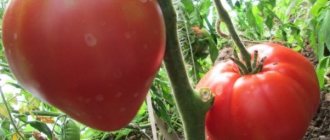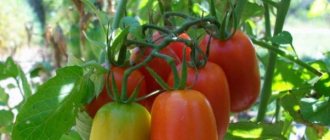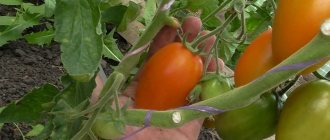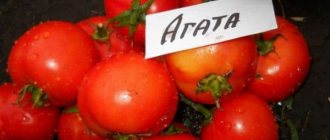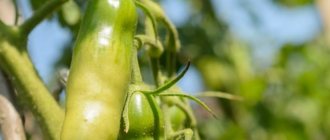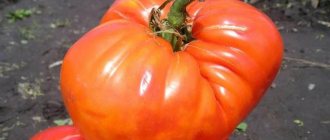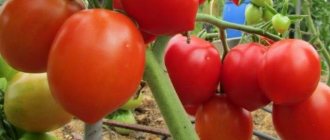Characteristics and description of the variety
The varietal crop was developed by Novosibirsk agricultural breeders in the 90s. It is intended for breeding even in the most severe climatic regions. Entered into the State Register in 1999.
Distinctive features
The bush is indeterminate, with a height of 80 cm in open ground, in a greenhouse it reaches 1.5 m. The stem is powerful, therefore it requires mandatory staking and pinching. The foliage is medium, the leaves are dark green. Each seedling forms 5-6 fruiting clusters, each cluster bears 5-6 fruits.
Mid-season species, 115-120 days pass from sowing to full ripening.
Productivity is high, from 1 sq. m, 6-7 kg of fruits are collected, planting no more than 4 seedlings per 1 sq. m. m.
Resistance to diseases is weak. The variety is susceptible to diseases such as late blight, tobacco mosaic and brown spot. For this reason, mandatory soil disinfection before planting and regular preventive measures are necessary.
The tomato is well adapted to temperature changes and unfavorable conditions.
Fruit characteristics
The average weight of tomatoes is 250-350 g. The shape is round, slightly flattened at the top, the color is pink-red, rich. The taste is sweet with barely pronounced sourness, characteristic of tomatoes. The pulp is dense, juicy, there are few seeds.
The peel is thick enough to withstand long-distance transportation. During transportation, tomatoes are placed in boxes in 2 or 3 layers.
Ripe vegetables are equally suitable for preparing fresh dishes and for winter preparations. When processed into tomato products, they produce excellent juices, pastes, ketchups, adjika and sauces.
The photo shows Sugar Pudovich tomatoes.
Characteristics of the variety
Sugar puff is considered a universal variety that is suitable for growing in any conditions. This tomato can withstand both the cool summer of Siberia and the drought of the Volgograd region. Therefore, the plant can be planted in any territory of the country. But you need to take into account that it is best to hide the plant from severe cold under a film cover. Both in the greenhouse and in open beds the plant will produce a very good harvest. But to obtain maximum fruitfulness, you must try to fulfill all the requirements of agricultural technology.
The tomato has been known to Russian gardeners for almost 2 decades. At the end of the last century, the variety was included in the state register. Sugar Pudovich tomatoes were bred and sold by the Siberian Garden company.
This tomato is classified as an indeterminate type. This characteristic suggests that the plant can have unlimited growth.
To get a good harvest, the gardener must pinch the top at a certain height. Otherwise, the bush will throw out more and more new branches, and it simply will not have enough strength to develop the existing fruits. In this case, a lot of tomatoes grow, but they are quite small.
Most often, the Sugar Pudovik stretches up to 1.5 m. Therefore, the plant is very suitable for greenhouse cultivation. If you choose open beds with plenty of sunlight as a permanent location, the height of the tomato may be smaller. After this, new clusters with fruits will stop forming.
The bushes turn out to be quite tall, so they require obligatory gartering to a support. Otherwise, the plant will collapse from the weight of the leaves and fruits. If the tomatoes end up on the ground, they will hurt. This threatens the loss of part of the harvest.
In addition to garter, indeterminate tomato varieties also require shaping. The plant grows quite lush, and some branches will be empty, without fruit. They are called stepchildren and require removal. Experts recommend leaving only 2 stems on Sugar Pudovik bushes. This will be enough to obtain a high-quality and large harvest.
If all agricultural technology requirements are met, large fruits can be obtained. But their ripening time will be average, so you shouldn’t wait for the Sugar Pudding harvest very early. Most often, from the moment of sowing seeds for seedlings until the first ripe tomatoes are obtained, about 110 days pass.
This variety requires high-quality and timely watering, as well as loosening and weeding of the soil. In addition, fertilizers should not be ignored. Without fertilizing, the average yield from 1 bush will be about 8 kg. If you grow Sugar Pudovik on well-fertilized soil, the number of fruits from each plant can exceed 12 kg. Considering that many heavy bunches of tomatoes form on the bushes, some of them should be additionally tied up. Otherwise, the fruits may fall to the ground.
When the tomatoes come into contact with the soil, they begin to hurt. So they immediately become infected with rot and late blight. The Sugar Pudovich variety has average resistance to diseases. Therefore, preventive spraying against diseases and pests will not be superfluous.
How to grow seedlings
Seeds for seedlings are sown 65-70 days before planting in the ground. The final sowing dates are determined by the climatic features of the region.
Seed preparation
Proper seed preparation is important for healthy seedling growth. Since this is not a hybrid, you can collect the seed yourself. Preparation consists of selecting high-quality seeds, disinfecting and improving germination.
First, the seeds are determined for internal filling by immersing them in a saline solution for 10 minutes. The solution is prepared from 1 teaspoon of salt and 1 glass of water. Empty grains will float to the surface. Disinfection consists of treatment with a solution of potassium permanganate. For 20 minutes, the seeds are immersed in a pink solution to disinfect the grains. After the procedure, they are thoroughly washed and dried.
To improve germination, seed material is left in a growth stimulator for 10 hours. A special preparation “Zircon” or melt water is used as a stimulant.
Reference . Melt water is obtained from snow, which is heated to room temperature.
The swollen seeds are ready for sowing.
Container and soil
The soil is prepared from garden soil and humus in equal proportions. Washed river sand is added as a leavening agent. All components are thoroughly mixed and steamed in the oven at a temperature of 60 ° C for 10 minutes or poured with a hot solution of dark potassium permanganate.
Reference . Disinfection of the soil when planting crops with weak immunity is mandatory.
The disinfected soil is laid out in planting containers, having previously made drainage holes at the bottom of each of them. In the absence of drainage holes, the accumulation of excess moisture can destroy the root system.
Plant in a common wooden box or separate paper honeycombs, plastic and peat cups. Before planting, any planting container is treated with a manganese solution.
Sowing
Seed material is sown in grooves 1 cm deep at a distance of 2 cm from each other. Sprinkle peat on top, lightly compact, water with warm, settled water using a spray bottle and cover with film. The containers are left in a warm room at a temperature of 24 ° C until the first shoots appear.
Seedling care
As soon as the first shoots appear, the film is removed and the containers are moved to the windowsill. Seedlings need sufficient light, otherwise the seedlings will begin to stretch and weaken. Daylight hours should be at least 13 hours. If there is a lack of natural light, add fluorescent lamps. Additional lighting should be taken care of in advance, especially in regions with short daylight hours.
Water the seedlings with moderately warm, settled water using a tablespoon. Over-wetting the soil increases the risk of the dangerous fungal disease blackleg. The black leg can ruin all plantings in the shortest possible time.
Reference . Blackleg is a collective popular name for many tomato diseases with common symptoms: blackening and rotting of the lower part of the stem.
The seedlings are picked after the appearance of 2 true leaves, planted in separate containers. When picking, only strong and healthy plants are left for further development.
If the bushes do not grow very well, they are fed with liquid fertilizer for tomato seedlings. Fertilizing is combined with regular watering.
After watering, the soil is loosened, ensuring air permeability of the soil.
2 weeks before transplanting into the ground, the seedlings are hardened off by taking them outside during the daytime at a temperature of 17 °C. Initially, the seedlings are left in the open air for 1 hour, gradually this time interval is increased to 12 hours.
Tomato Sugar Pudovich: characteristics, description of the variety with photos and videos, reviews, yield
Every gardener enjoys planting tomatoes. Every time you choose a new variety, you want the harvest to be more generous and the taste to be a pleasure.
One of these tomatoes is the Sugar Pudovich variety. Many gardeners know Sugar Pudovik under other names: Pudovik, Sevruga . But this does not in any way reduce their need for their favorite variety.
Characteristics and description of the variety with photos
It was bred by qualified breeders specifically for demanding summer residents of any region of the country. The crop can be grown under film, in open beds, in greenhouses
The advantageous difference between Pudovichok and other tomatoes with similar characteristics is that it is not a hybrid. Anyone can select seed from ripe fruits and use it to grow tomatoes without fear of losing their original maternal qualities.
The mid-early culture is indeterminate. The first ripe tomatoes can be tasted 4 months after emergence. In open areas, the bush has a height of 0.8-1 meter, but there have been cases when these dimensions reached 1.5 m. In greenhouse conditions, the dimensions are somewhat different - 1.5-2 m, and sometimes even 2.5 meters.
A large and powerful bush needs a good garter, and constant pinching is also required. Increased branching visually increases the size, and a tomato with a long stem seems simply giant. The color and shape of the tops is similar to potato tops.
The inflorescence of the Sugar Pudovich is unremarkable and differs little from standard brushes. The tomato received its unusual name thanks to its fruits - large, juicy and fleshy. When ripe, they have a slightly flat shape and are red in color.
Each tomato contains 4 seed chambers with a small number of seeds. It is noteworthy that the seeds are easily separated from the pulp, since they lack a protective shell.
The high dry matter content allows tomatoes to be used for making sauces and pastes.
The tomato does not have internal voids, and the flesh itself looks granular and sugary. And the taste matches this quite well. With the most unpretentious care, the weight of the fruit reaches 0.5 kg, and if you follow all care recommendations in a timely manner, tomatoes weighing 1 kg are not at all uncommon.
For all its size and juiciness, Pudovichok is perfectly stored and can be easily transported.
Advantages and disadvantages of the variety
Gardeners unanimously consider the high quality of tomatoes to be the main advantages of the variety: their taste, transportability, and versatility of use.
The plant also tolerates temperature changes and thrives in harsh climates. Consumers are pleased with the high yields and, especially, the care that is not at all difficult.
Gardeners divide the disadvantages according to complexity:
- The main thing is the formation of the bush. The plant's tendency to thicken complicates this process, since stepsons and shoots are constantly being formed. It is not enough for an inexperienced person to simply navigate and carry out the procedure correctly.
- Secondary ones are not very complex, but they are mandatory, since the future harvest depends on them. This is pinching, gartering, watering.
- Minor ones that are simply necessary, like all crops: treatment against pests and diseases.
Productivity
The mid-early variety Pudovichok is primarily intended for cultivation in the middle zone. Residents of the Moscow region, the Far East, and Siberia reap good harvests. As for the more northern regions, tomatoes are grown there in greenhouses: glass, polycarbonate, film.
The most inexperienced consumer will be able to remove 10 kg of harvest from the Pudovichka bush. Experienced gardeners have higher results: from 1 bush they collect 30-36 fruits, and considering their mass, the result is quite a decent weight.
Even if each tomato weighs 0.5 kg, then you can actually get 15 kg of tomatoes from a plant. Since proper care allows you to grow giant fruits weighing 1 kg, it is quite possible to get almost 30 kg from a bush.
Other interesting tomato varieties:
Features of cultivation and care
The versatility of the plant is expressed not only in the use of tomatoes, but also in cultivation - it can be grown anywhere, even on the balcony.
To get a harvest, you must go through 2 stages of cultivation:
- Obtaining seedlings;
- Growing an adult bush.
In order for the seedlings to be strong and healthy, the Sugar Pudovik needs fertile soil and frequent ventilation. The sowing time is determined by subtracting 2 months from the expected period of planting in a permanent place. Typically this date falls at the beginning of March.
Sowing is carried out using standard methods. Grown seedlings that have a pair of leaves dive, allocating each sprout a separate container.
If the seedlings are intended for greenhouses, then by the time of planting there should be formed brushes on them, but not yet beginning to bloom. The plants are transplanted into warm soil, after removing old roots and weeds.
The best landing option is a checkerboard pattern. Moreover, bushes with 1 stem are placed at a distance of 0.6 m, and with 2 stems - 0.7 meters.
The greenhouse is maintained at approximately the same temperature - about +30ºС, with frequent ventilation. For high-quality pollination, the Sugar Pudovichok is shaken during flowering.
To plant in open areas, you should be guided by the climatic conditions of the region. Place the seedlings in the same way as in the greenhouse version.
As for watering, it is carried out as necessary when the soil dries out. An abundance of moisture leads to cracking of the fruit. For feeding before flowering, mainly nitrogen compounds are used, gradually adding organic matter. After fruit set, they switch to potassium and phosphorus fertilizing.
In open ground, tomatoes are very afraid of fogs. The harvest should be harvested before their appearance. The fruits ripen in dark places.
Reviews from gardeners
Peter, Moscow region
The first time I planted Pudovichok near the house, right in the beds. I didn’t grow the seedlings - I sowed them directly into the holes, covered them with cut bottles, and buried them so well - about 10 cm.
And he also covered it with buckets at night. I planted a few, a dozen bushes. The tomatoes have all grown, so strong and spreading. I put up the trellises and tied up each tassel.
My wife loosened, fed, and pushed me around so that the water would be warm for irrigation.
But I was pleased with the harvested harvest - oh, how big and tasty - like sugar loaves. And we ate to our heart's content and finished with salads. And next year, even the seeds were chosen from the largest tomato. It weighed almost 800 grams.
Alexandra, Chita region
This is not the first year I have been growing Sugar Pudovich. True, we call it differently - stellate sturgeon. This is what I later read, which is the correct name. So I process almost the entire harvest into sauces and pastes. Such preparations are incredibly tasty and have a delicate consistency. Dried Pudovichok is also very good. The children read this recipe on the Internet. Try it, it's really delicious.
Good varieties of tomatoes for the greenhouse: video
Remarkable productivity and excellent taste, ease of care and universal use - these are all that every gardener needs, and the Sugar Pudovichok tomato has all these qualities.
Source: https://1001sort.ru/tomat-saharnyj-pudovichok.html
How to grow tomatoes
The seedlings are transplanted into the soil after it warms up to 16 °C. By this time, the bushes have a fully developed root system, capable of quickly adapting to new conditions.
Landing
For 1 sq. m place no more than 4 seedlings in a checkerboard pattern. This method of planting ensures that each plant receives the required amount of sunlight. In addition, the bushes will be freely ventilated, which prevents the development of fungal infections.
The soil is prepared 2 weeks before planting by digging with the addition of wood ash. Replant in the evening after sunset in shallow holes. The seedlings are installed vertically and buried down to the first leaves.
Further care
Regular watering is established as soon as the seedlings take root in a new location. The average adaptation time is no more than 8 days. Water with settled water under the root without flooding the holes. The culture responds well to drip irrigation. With such an irrigation system, waterlogging of the beds is impossible.
After watering, the soil is loosened and hilled up. This technique improves the penetration of oxygen to the roots, which is necessary for healthy plant growth.
To keep the beds moist, they are mulched with straw, sawdust or dry leaves. Mulching also serves as a preventive measure in pest control.
The crop is fed 4-5 times throughout the season, but the ideal option is to fertilize once every 2 weeks. The fertilizer is a full complex of mineral substances, which alternate with organic matter. During the flowering period, boric acid is added to the fertilizer, fertilizing with substances mainly containing phosphorus, and during fruiting the plants are fed with potassium fertilizers. From organic matter, mullein infusion is used in a dilution of 1:10.
Features of cultivation and possible difficulties
The culture requires mandatory formation, since this factor affects the quantitative indicator of fruiting. When planted in 2 stems, gardeners achieve maximum yield. To do this, remove all the stepsons above the first flower raceme, leaving only one lower lateral process. At the moment of fruit set, those leaves that are located below are removed.
When transplanting, a support is installed next to each seedling to attach the stem and fruit-bearing branches to it. The stem is fixed almost immediately, which has a beneficial effect on its formation. The main stem grows even and strong. Fruitful branches are fixed as they grow. Loose ones will not support the weight of ripe vegetables and will break.
Diseases and pests
The variety is not highly resistant to dangerous diseases and can become a victim of both fungal and viral diseases. Of the diseases with fungal etiology, late blight is considered the most dangerous. When plants are damaged, it destroys up to 70% of all plantings. To prevent fungus from entering the beds, it is necessary to carry out prevention.
Late blight is not a death sentence or how to overcome late blight
By following the rules of crop rotation, gardeners strengthen the immunity of plants by planting them in places where they will receive the greatest amount of nutrients. According to these rules, tomatoes cannot be planted in beds where potatoes, peppers or eggplants previously grew. These crops also belong to the nightshade family and are affected by the same diseases. After them, pathogenic spores may remain in the soil, which will cause irreparable harm to the tomato crop.
Moderate watering with moisture control in the beds will prevent humidity from rising, thereby reducing the risk of the spread of fungal spores.
When affected by fungal infections, fungicidal agents are used, for example, Fitosporin or HOM.
As for viral diseases, it is impossible to save plants once they are infected, so they are simply burned. Prevention consists of removing weeds with roots. Once every 10 days, the bushes are watered with a weak solution of manganese and periodically sprayed with a milk solution. A milk solution is prepared from 100 ml of whey diluted in 1 liter of boiled water.
Of the pests, the greatest danger to tomatoes is spider mites and cutworms. The armyworm is a garden caterpillar that feeds on leaves, causing the plant to weaken and die. The cutworm also causes damage to fruits by eating them. As a result, they fall off before reaching ripeness. To combat it, eggshells are scattered between the rows, which prevents the cutworm from crawling out of the ground. Strong-smelling herbs - basil, cilantro - are planted next to the tomatoes. Their smells repel caterpillars.
To get rid of spider mites, it is enough to ventilate closed structures daily. Spider mites are a greenhouse pest. The influx of fresh air destroys its usual habitat.
Diseases and pests of the Sugar Pudovich variety
Although the variety in question tolerates harsh climates well, it is not resistant to many diseases and pests. The most common enemies of this crop are late blight and tobacco mosaic infection. In greenhouse conditions, tomatoes often suffer from brown spot. Among the insects that harm plants are cutworm caterpillars, spider mites, and wireworms.
To avoid these troubles you need to:
- antiseptic treatment of seeds and soil;
- treatment of bushes with special means aimed at protecting against diseases and pests.
Nuances for open ground and greenhouses
The tomato is recommended for growing in open ground in the southern region and the middle zone. In harsh Siberian conditions, the crop is planted in greenhouses.
In greenhouses, plant growth reaches 1.5 m. If it is necessary to limit growth, the crown of the plants is pinched.
Every year it is recommended to replace the top layer of soil in the greenhouse with a new one. This is explained by the fact that pathogenic spores and many pests successfully overwinter in the ground, and become more active in the spring when crops are planted. The new soil layer must be spilled with a hot solution of potassium permanganate and treated with copper sulfate. The walls of protected structures are sprayed with Bordeaux mixture.
In regions with short and cool summers, additional lighting is installed in greenhouses for the full development of seedlings. With sufficient light, the stem does not stretch, becoming strong and even.
In open ground, excessive watering negatively affects the taste of fruits, making them watery. In addition, the fruits may crack.
Care
Tomatoes of the Sugarpuff variety require several necessary care procedures: watering, adding nutrients, mulching and pruning. Additional measures include loosening the top layer of soil and removing weeds. Fertilizers must be applied according to a specific schedule.
- At the end of May - a solution of nitrate (200 g per 6 liters of water).
- In mid-June - potassium nitrate (1 ampoule per 3 liters of water).
- In August, superphosphate 30 g per 5 liters of water.
Young plants are watered once a week. Adult bushes need plenty of moisture, so the interval is reduced to 4 days. After watering, it is recommended to loosen the soil and remove weeds. This reduces the risk of diseases and pests, and the root system will not rot.
At the end of August, mulch using humus or sawdust. This will protect the soil and roots from possible cold snap.
():
Mulch under plants can be used from the first day after planting seedlings. This protects the earth from moisture evaporation and overheating of the soil on hot days.
Pruning the crop involves removing side shoots and thinning the plant. This is necessary so that the sun's rays penetrate inside the bush and the fruits ripen faster.
TOMATO SUGAR POOD. REVIEW. Olga Chernova.
Tomato Sugar Pudovich - description of the variety
SIBERIAN TOMATO PUDOVIK - LARGE, BEAUTIFUL AND TASTY! Olga Chernova.
Harvesting and application
3.5-4 months after sowing, they begin to harvest the crop . The fruits are collected as they ripen, thereby unloading the bush for the ripening of the next batch. Overripe fruits may crack.
The purpose in cooking is universal: tomatoes are ideal in fresh dishes and winter preparations. They are used for preparing salads, various appetizers, slices, hot and vegetable dishes, and added when baking with meat. Their large sizes do not allow them to be prepared as a whole, but when cut they do not lose their taste at all, so they are salted and pickled not only individually, but also mixed with other varieties. When processed, vegetables are used to produce excellent juices, pastes, lecho, sauces, adjika and ketchups.
Ripe vegetables can be stored for a long time, following the basic rules, namely, not stacking them in high rows on top of each other. The room in which tomatoes are stored should be dry and cool.
Fruit characteristics
When ripened, tomatoes of the Sugar Pudovik variety acquire a red color. The fruits have a flat-round shape, without ribbing, characteristic of some varieties of tomatoes. They have a slightly sweet taste. The fruits are quite large. The weight of one can reach up to 0.5 kilograms or more.
See also
Description of the Korean long-fruited tomato variety, its characteristics and yieldRead
The fruits have 3–4 seed chambers. The few seeds do not have a shell to protect them and are easily separated from the tomato pulp. The amount of dry matter in tomatoes is very high, which allows you to prepare delicious salads and add them to snacks, preserve them and prepare sauces and pastes.
Advantages and disadvantages
Based on the varietal characteristics and reviews with photos, we list the advantages of the variety:
- the ability to adapt to unfavorable conditions;
- simple agricultural technology;
- high yield;
- excellent taste;
- large fruits;
- universal purpose;
- long transportation;
- Possibility of self-selection of seeds.
The main disadvantage of the culture is weak immunity to dangerous diseases of the nightshade family. This also includes the necessary staking of plants and regular removal of stepsons.
Tomato
Tomatoes are certainly one of the most popular crops among Russian gardeners. Every year at the beginning of the season, domestic summer residents look for the best - the most unpretentious and productive varieties of tomatoes.
And of course, breeders pay maximum attention to this crop. Accordingly, today there are many good varieties of tomatoes.
For example, in your garden you can plant a very tasty and easy-to-care tomato called “Sugar Pudovich”.
Where and by whom was it bred?
This wonderful productive variety was registered in the 90s of the last century. It was developed by specialists widely known in our country. This agricultural company is located in the Novosibirsk region and is currently the largest supplier of planting material for garden crops in Russia.
How to start a goat before lambing in winter?
General description of the “Sugar Pudovich” tomato
This variety is intended for cultivation both in open ground and in a greenhouse. According to the statement, it does not grow higher than 80 cm. In a greenhouse, the length of the stem of this tomato can reach 1.2 m. The yield of this tomato, subject to proper care, is usually 8-10 kg per bush.
Potatoes Lorch: description, growing features, photos
The growing season for Sugar Pudovich, like other tomatoes, is long. That is, it needs to be grown using seedlings. When planted both in open ground and in a greenhouse, this variety requires garter to supports.
Is it possible to can
Thus, the fruits of the “Sugar Pud” grow very large. But many summer residents still advise using them for canning. Bushes of this variety are distinguished by high productivity.
And it won’t be difficult to collect not too large fruits from them for pickling in general. Also, these tomatoes are just great for pickling according to the “dessert slices” recipe. In this way, you can also harvest large fruits of this variety by cutting them into pieces.
In canned form, judging by the reviews, “Sugar Pudovichok” tomatoes are also very tasty.
Disadvantages of the variety
Thus, most summer residents recommend buying “Sugar Pudovik” seeds for your plot. This unpretentious variety has many advantages.
But these tomatoes also have some disadvantages. First of all, it is not too high resistance to diseases. In open ground, the “Sugar Pudovik” tomato can infect late blight.
In a greenhouse, such tomatoes often suffer from brown spot.
Growing seedlings
Like most other tomato varieties, “Sugar Pudovich” requires planting in boxes 60-90 days before transfer to open ground. That is, these tomatoes need to be sown in March-April. Seedlings of these tomatoes are grown using standard technology.
The young bushes of “Sugar Pud” grow quite large on the windowsill. Therefore, you should not rush too much with planting seeds of this variety. The soil in the boxes must be disinfected a day before sowing by pouring hot water. Unfortunately, this variety is not very resistant to diseases.
The seeds of the “Sugar Pudovik” are buried in the ground in grooves of 1.5 cm. After the emergence of seedlings, the seedlings are transferred to a bright place and then periodically watered. If desired, in the phase of two true leaves, you can pick seedlings of this variety.
These tomatoes are transferred to open ground at the end of May. Place them on the garden bed (as in the greenhouse) in the amount of 3-5 pieces. per 1 m2.
Features of care in summer
In the warm season, the technology for growing “Sugar Pudovik” tomatoes is also used standard. That is, they fertilize tomatoes three times a season and try to water them not too often, but abundantly.
Tomatoes of this variety do not form a bole. They are grown by summer residents both in greenhouses and in open ground using the two-shoot method. This method allows you to get the best results in terms of yield.
The manufacturer, as already mentioned, notes in the instructions for these tomatoes that in open ground they do not grow higher than 80 cm. However, many summer residents refute this in their reviews on the Internet. Both in open ground and in a greenhouse, with good care, as gardeners note, these tomatoes can grow up to 2 m in height.
This variety can develop several fruits on one cluster. Ripe “Sugar Pudovik” tomatoes weigh a lot. Therefore, experienced summer residents advise tying up bunches of fruit. Otherwise, they may simply break off.
Spraying against late blight and brown spot
The fact that this variety is not resistant to the most common nightshade diseases has already been mentioned above in the description of the “Sugar Pudovich” tomato. According to reviews from summer residents, these tomatoes are indeed, unfortunately, often infected with late blight and brown spot.
To prevent the development of these diseases on Sugar Pudovich plantings, therefore, preventive spraying should be carried out.
For this purpose, you can use both fungicides, for example, Bordeaux mixture, and folk remedies - whey, garlic infusion, etc.
To prevent the development of such diseases, you need to water tomatoes only at the root in the summer. The greenhouse with such tomatoes should also be ventilated periodically. Sugarpuff tomatoes usually get sick due to high humidity in the environment.
Source
Source: https://vkmp.ru/selskoe-hozjajstvo/7334-tomat-saharnyj-pudovichok-opisanie-osobennosti-vyrashhivanija-foto
Farmer reviews
Despite the existing shortcomings, reviews of the culture are positive. Here are some opinions from gardeners:
Galina, Novokuznetsk: “ The tomatoes began to grow large, up to 600 g, tasty, fleshy, fragrant, with a small amount of seeds. But these seedlings were the first to get sick. The leaves turned brown and began to dry out. I didn’t wait, I picked the tomatoes unripe. The vegetables picked up color perfectly on their own at room temperature. The taste was amazing. I’d like to plant it again because of the taste.”
Galina, Omsk: “I planted the Sugar Pudovichok tomato variety for the first time. The height reached 2 m. The productivity is high, the immunity is strong - the plants did not suffer from anything throughout the season. The tomatoes are large, tasty, with sugar on the break. It was enough to eat in the summer and wind up for the winter. I'm very pleased. I collected the seeds myself for planting next year.”
Characteristics
- The fruits of the Sugar Pudovik in a ripe state are red, flat-round, even.
- The fruit size is large, the average weight of one tomato reaches 500-600 g.
- The dry matter content is high.
- There are more seed chambers than in small-fruited tomatoes; their number on average is about 3-4 pieces.
- The seeds are few, small, without a pronounced protective film shell, and are easily separated from the pulp.
Thanks to the low amount of juice and high amount of solids, Sugar Pudovich is excellent for preparing fresh salads and snacks, for preparing pasta or sauces, as well as canning salads.
You can compare the weight of the fruits of this variety with others in the table:
| Variety name | Fruit weight |
| Sugar Pudding | 500-600 grams |
| Yellow giant | 400 grams |
| Inseparable hearts | 600-800 grams |
| Gypsy | 100-180 grams |
| Marissa | 150-180 grams |
| Dusya red | 150-300 grams |
| Pink King | 300 grams |
| Black pear | 55-80 grams |
| Icicle Black | 80-100 grams |
Reviews from gardeners
Peter, Moscow region
The first time I planted Pudovichok near the house, right in the beds. I didn’t grow seedlings - I sowed them straight into holes, covered them with cut bottles, and deepened them so well - about 10 cm. And I also covered them with buckets on top at night. I planted a few, a dozen bushes. The tomatoes have all grown, so strong and spreading. I put up the trellises and tied up each tassel. My wife loosened, fed, and pushed me around so that the water would be warm for irrigation.
But I was pleased with the harvested harvest - oh, how big and tasty - like sugar loaves. And we ate to our heart's content and finished with salads. And next year, even the seeds were chosen from the largest tomato. It weighed almost 800 grams.
Alexandra, Chita region
This is not the first year I have been growing Sugar Pudovich. True, we call it differently - stellate sturgeon. This is what I later read, which is the correct name. So I process almost the entire harvest into sauces and pastes. Such preparations are incredibly tasty and have a delicate consistency. Dried Pudovichok is also very good. The children read this recipe on the Internet. Try it, it's really delicious.

